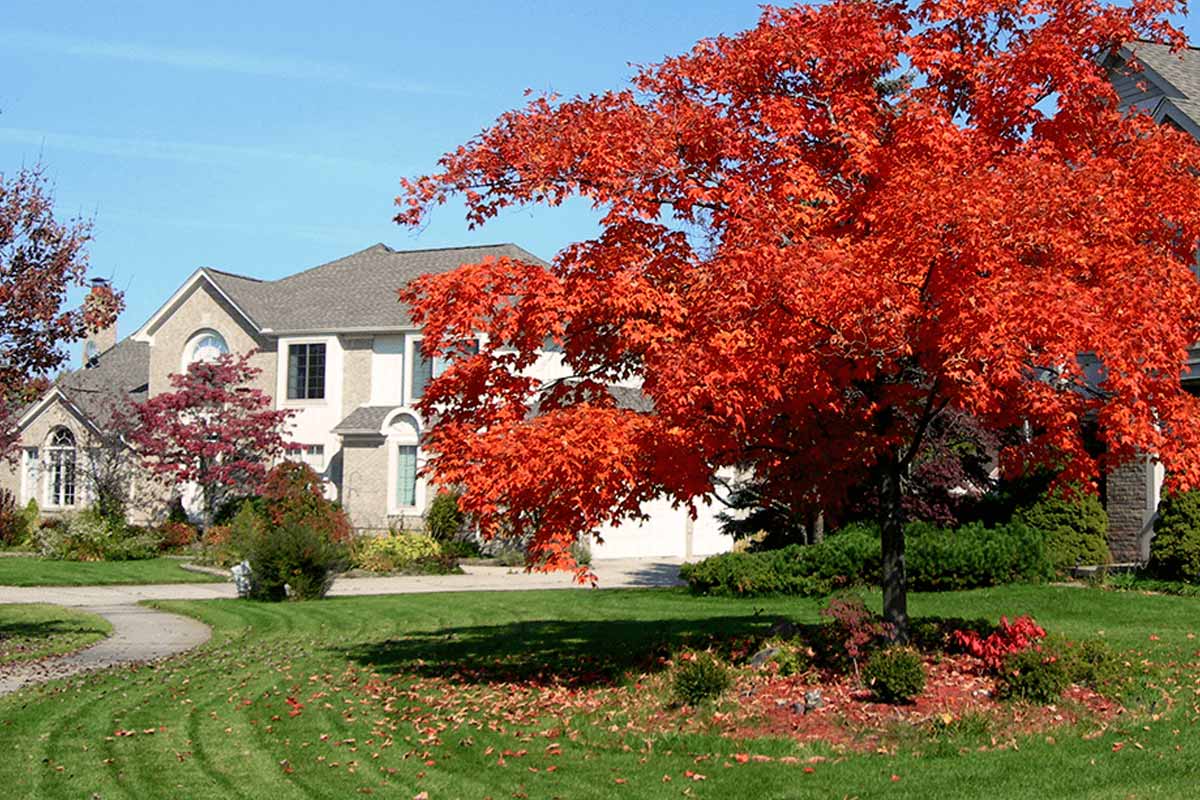A blank lawn looks vast, yet it can feel lifeless. Swap monotony for layered shade, color, and movement, and you change the whole mood. Small, fast-maturing trees add wildlife, cast cooling shadows, and finish a design without decades of waiting. The options below top out between 15 and 35 feet, reach form quickly, and shine across the seasons. Pick by climate, growth rate, and look, then let the canopy work while you relax instead of mowing.
Small choices, big impact for spacious landscapes
Mimosa (Albizia julibrissin) reaches 20 to 35 feet in about ten years, so it delivers presence fast. Feathery foliage frames fragrant rosy pink blooms from mid to late summer, then long brown pods hang into fall. Hardy in USDA zones 6–9, this sun lover suits patios and drives where dappled shade feels welcome among trees.
Amur maple (Acer ginnala) stays compact at 15 to 25 feet, yet it punches above its size. Spring brings creamy white flowers with fresh leaves. Autumn explodes into reds, yellows, and oranges. Grow it as a large shrub or a single-stem specimen. Cold hardy in zones 3–7, it thrives where winters bite and space is tight.
Willow acacia (Acacia salicina), also called Australian willow, matures rapidly to 15 to 25 feet. Its evergreen, wispy leaves and weeping habit soften walls, fences, and hot corners. Autumn produces fluffy yellow flowers followed by delicate pods. Drought adapted and low fuss, it suits dry sites in zones 8–12 while keeping maintenance light.
Fast growers with multi-season charm: trees that thrive
Blue palo verde (Cercidium floridum) brings desert character and striking color. This small tree can reach 35 feet, with blue-green stems and foliage that glow in strong sun. One of the earliest spring bloomers, it covers itself in bright yellow flowers. Heat-loving and resilient, it prospers in zones 9–12 with lean soil and open sky.
Japanese maple (Acer palmatum) grows one to two feet per year, topping out near 15 feet. Its branching reads like sculpture, while deep red forms anchor paths and water features. Autumn color is consistently vivid. Ideal for courtyards and entry beds, these refined trees flourish in dappled light across zones 5–8 and prefer steady moisture.
Shadblow serviceberry (Amelanchier canadensis) rarely exceeds 20 feet and often forms a graceful multi-stem. It races to 10 feet in roughly five years, then shifts into a seasonal rhythm. Spring smells sweet with white blossom, summer fruits are edible and decorative, and fall foliage warms to golden yellow. Native charm and toughness suit zones 3–7.
Compact focal points with color, fruit, and form
Magnolia ‘Jane’ matures quickly to 10–12 feet and steals spring with large pink goblet flowers. Buds can reappear on and off into summer, so the display lingers. Exceptionally cold tolerant for a magnolia, it brings a classic look to entry beds in zones 4–9 without crowding windows, walks, or view lines.
Flowering dogwood (Cornus florida) grows about one to two feet per year, settling between 15 and 30 feet. Young specimens may bloom sparsely for five years; patience pays, as spring bracts later arrive reliably. Horizontal branching creates elegant layers. Underplant with shade perennials and enjoy four-season structure in zones 5–8 near lawn edges.
‘Nellie R. Stevens’ holly (Ilex hybrid) delivers privacy and berries fast, extending two to three feet yearly. Dark evergreen leaves shine against walls, while bright red fruit lights winter beds. Left alone it approaches 30 feet; pruning holds any height. Drought tolerant and durable, it anchors hedges and corners in zones 6–9, feeding birds.
Regional fit, growth speed, and four-season payoffs
Crabapple (Malus hybrid) grows about a foot a year, finishing between 8 and 15 feet. Spring brings a cloud of white or pink blossom, then small fruits feed birds through fall and early winter. Cold hardy in zones 5–8, it pairs well with ornamental grasses and open mulch, where airy branching reads clean.
Semi-dwarf cherry (Prunus cerasus) stands 15–18 feet at maturity while keeping harvest easy. Spring fragrance signals a heavy bloom set, then sweet or tart fruit follows in summer. The compact frame invites netting and light pruning. Plant near seating for shade and scent, and enjoy productive trees across zones 4–8 with good drainage.
Little leaf linden ‘Greenspire’ (Tilia cordata) stays low maintenance yet grows fast. While it can reach 50 feet high and wide, careful siting turns it into a generous anchor for big beds. Scented flowers hum with bees, building pollinator life and summer shade. Hardy in zones 3–8, it rewards deep, infrequent watering.
Practical planting, watering, and care habits for long-lived trees
Match climate first using USDA zones listed above, since fit decides success and speed. Choose sun or shade based on species needs, then check mature width before digging. Space holes so canopies can meet but not choke. Because air flow reduces disease, plan beds with space for mulch rings and low groundcovers.
Set root flare level with the soil, then water deeply, slowly, and on a schedule. Young plants prefer weekly soakings, while established specimens need less frequent but deeper sessions. Use two to three inches of mulch, pulled back from trunks. As wind protection and form insurance, stake only if the site demands it.
Prune for structure during dormancy and remove crossing or damaged wood as needed. Light shaping preserves flowers and fruit. Expect usable scale in five years for serviceberry and cherry, and notable height in ten to fifteen years for most. Replace thirsty turf under canopies with shade perennials, so care declines while seasonal interest climbs for trees.
A lasting canopy effect without the long wait or heavy work
Swap routine mowing for layered shade, wildlife, and seasonal color, and you gain calm fast. Pick climate-ready species, site them well, and water with intent, and the canopy builds itself. When scale matters, small, fast-maturing trees make big spaces feel complete, so you enjoy comfort, texture, and life sooner and with less effort.
